Human Resource Development Report: ALDI and Learning Styles
VerifiedAdded on 2020/09/03
|18
|5473
|351
Report
AI Summary
This report delves into the realm of Human Resource Development (HRD), specifically examining learning styles and their impact on training programs within organizations. It begins with an introduction to HRD and its importance, followed by an analysis of different learning styles, including Kolb's model and Honey and Mumford's approach, and their significance in the workplace. The report then explores the role of the learning curve and the importance of learning transfer. It also investigates the requirements of training needs at various organizational levels, the advantages and disadvantages of different training methods, and the planning of training and development programs. Furthermore, the report evaluates training events, analyzes their success, and examines the role of government in training and development, including contemporary initiatives introduced by the UK government. The report uses ALDI as a case study to illustrate the practical application of these concepts.
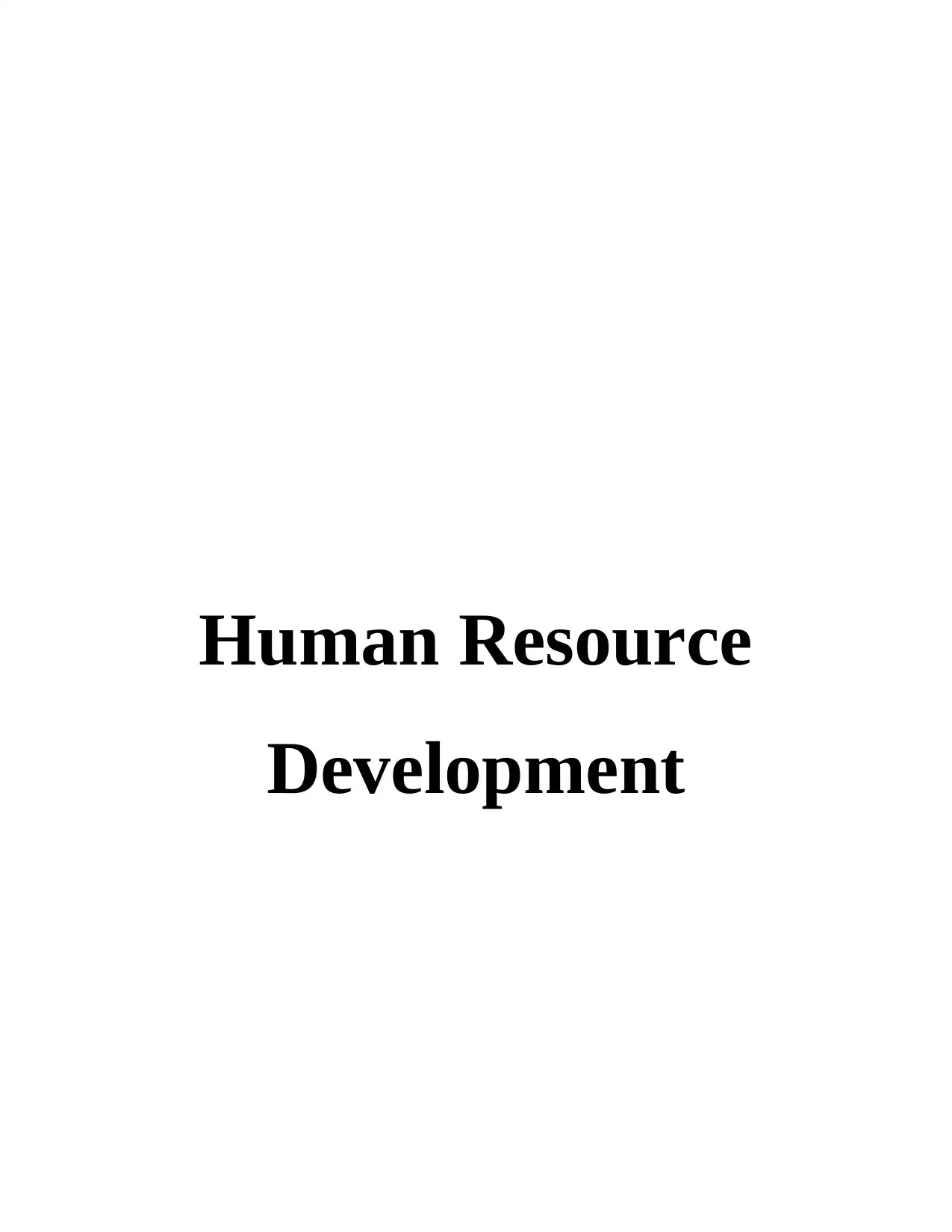
Human Resource
Development
Development
Paraphrase This Document
Need a fresh take? Get an instant paraphrase of this document with our AI Paraphraser
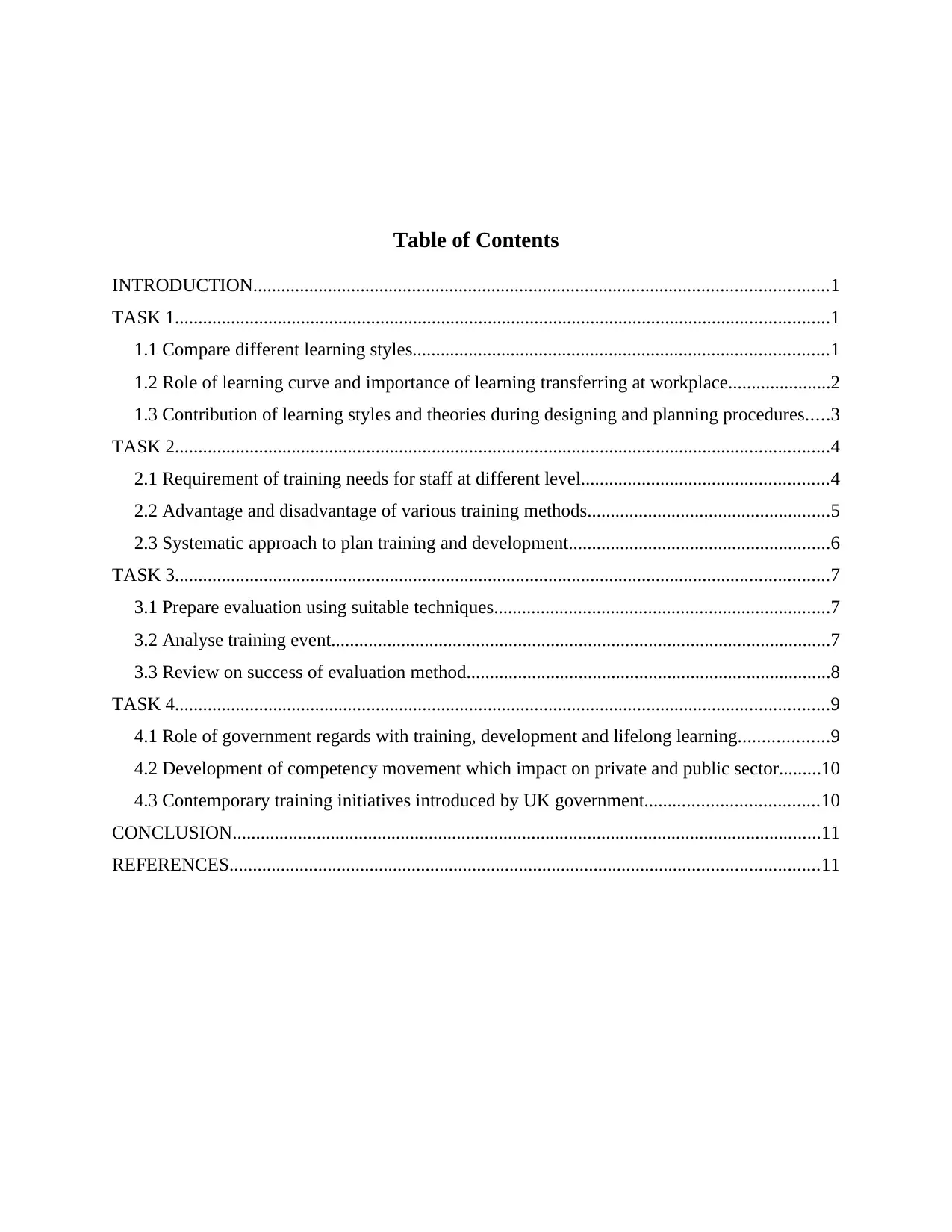
Table of Contents
INTRODUCTION...........................................................................................................................1
TASK 1............................................................................................................................................1
1.1 Compare different learning styles.........................................................................................1
1.2 Role of learning curve and importance of learning transferring at workplace......................2
1.3 Contribution of learning styles and theories during designing and planning procedures.....3
TASK 2............................................................................................................................................4
2.1 Requirement of training needs for staff at different level.....................................................4
2.2 Advantage and disadvantage of various training methods....................................................5
2.3 Systematic approach to plan training and development........................................................6
TASK 3............................................................................................................................................7
3.1 Prepare evaluation using suitable techniques........................................................................7
3.2 Analyse training event...........................................................................................................7
3.3 Review on success of evaluation method..............................................................................8
TASK 4............................................................................................................................................9
4.1 Role of government regards with training, development and lifelong learning...................9
4.2 Development of competency movement which impact on private and public sector.........10
4.3 Contemporary training initiatives introduced by UK government.....................................10
CONCLUSION..............................................................................................................................11
REFERENCES..............................................................................................................................11
INTRODUCTION...........................................................................................................................1
TASK 1............................................................................................................................................1
1.1 Compare different learning styles.........................................................................................1
1.2 Role of learning curve and importance of learning transferring at workplace......................2
1.3 Contribution of learning styles and theories during designing and planning procedures.....3
TASK 2............................................................................................................................................4
2.1 Requirement of training needs for staff at different level.....................................................4
2.2 Advantage and disadvantage of various training methods....................................................5
2.3 Systematic approach to plan training and development........................................................6
TASK 3............................................................................................................................................7
3.1 Prepare evaluation using suitable techniques........................................................................7
3.2 Analyse training event...........................................................................................................7
3.3 Review on success of evaluation method..............................................................................8
TASK 4............................................................................................................................................9
4.1 Role of government regards with training, development and lifelong learning...................9
4.2 Development of competency movement which impact on private and public sector.........10
4.3 Contemporary training initiatives introduced by UK government.....................................10
CONCLUSION..............................................................................................................................11
REFERENCES..............................................................................................................................11
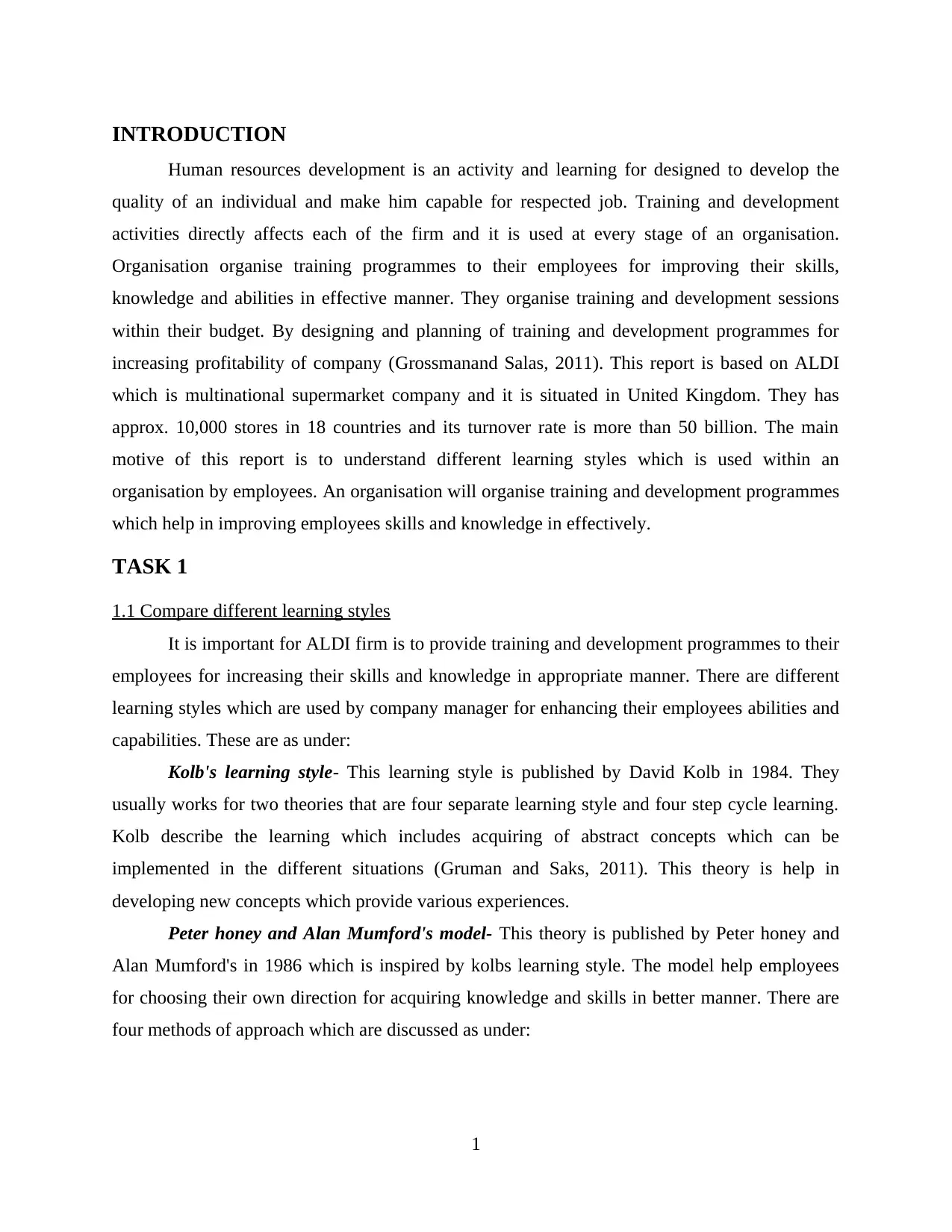
INTRODUCTION
Human resources development is an activity and learning for designed to develop the
quality of an individual and make him capable for respected job. Training and development
activities directly affects each of the firm and it is used at every stage of an organisation.
Organisation organise training programmes to their employees for improving their skills,
knowledge and abilities in effective manner. They organise training and development sessions
within their budget. By designing and planning of training and development programmes for
increasing profitability of company (Grossmanand Salas, 2011). This report is based on ALDI
which is multinational supermarket company and it is situated in United Kingdom. They has
approx. 10,000 stores in 18 countries and its turnover rate is more than 50 billion. The main
motive of this report is to understand different learning styles which is used within an
organisation by employees. An organisation will organise training and development programmes
which help in improving employees skills and knowledge in effectively.
TASK 1
1.1 Compare different learning styles
It is important for ALDI firm is to provide training and development programmes to their
employees for increasing their skills and knowledge in appropriate manner. There are different
learning styles which are used by company manager for enhancing their employees abilities and
capabilities. These are as under:
Kolb's learning style- This learning style is published by David Kolb in 1984. They
usually works for two theories that are four separate learning style and four step cycle learning.
Kolb describe the learning which includes acquiring of abstract concepts which can be
implemented in the different situations (Gruman and Saks, 2011). This theory is help in
developing new concepts which provide various experiences.
Peter honey and Alan Mumford's model- This theory is published by Peter honey and
Alan Mumford's in 1986 which is inspired by kolbs learning style. The model help employees
for choosing their own direction for acquiring knowledge and skills in better manner. There are
four methods of approach which are discussed as under:
1
Human resources development is an activity and learning for designed to develop the
quality of an individual and make him capable for respected job. Training and development
activities directly affects each of the firm and it is used at every stage of an organisation.
Organisation organise training programmes to their employees for improving their skills,
knowledge and abilities in effective manner. They organise training and development sessions
within their budget. By designing and planning of training and development programmes for
increasing profitability of company (Grossmanand Salas, 2011). This report is based on ALDI
which is multinational supermarket company and it is situated in United Kingdom. They has
approx. 10,000 stores in 18 countries and its turnover rate is more than 50 billion. The main
motive of this report is to understand different learning styles which is used within an
organisation by employees. An organisation will organise training and development programmes
which help in improving employees skills and knowledge in effectively.
TASK 1
1.1 Compare different learning styles
It is important for ALDI firm is to provide training and development programmes to their
employees for increasing their skills and knowledge in appropriate manner. There are different
learning styles which are used by company manager for enhancing their employees abilities and
capabilities. These are as under:
Kolb's learning style- This learning style is published by David Kolb in 1984. They
usually works for two theories that are four separate learning style and four step cycle learning.
Kolb describe the learning which includes acquiring of abstract concepts which can be
implemented in the different situations (Gruman and Saks, 2011). This theory is help in
developing new concepts which provide various experiences.
Peter honey and Alan Mumford's model- This theory is published by Peter honey and
Alan Mumford's in 1986 which is inspired by kolbs learning style. The model help employees
for choosing their own direction for acquiring knowledge and skills in better manner. There are
four methods of approach which are discussed as under:
1
⊘ This is a preview!⊘
Do you want full access?
Subscribe today to unlock all pages.

Trusted by 1+ million students worldwide
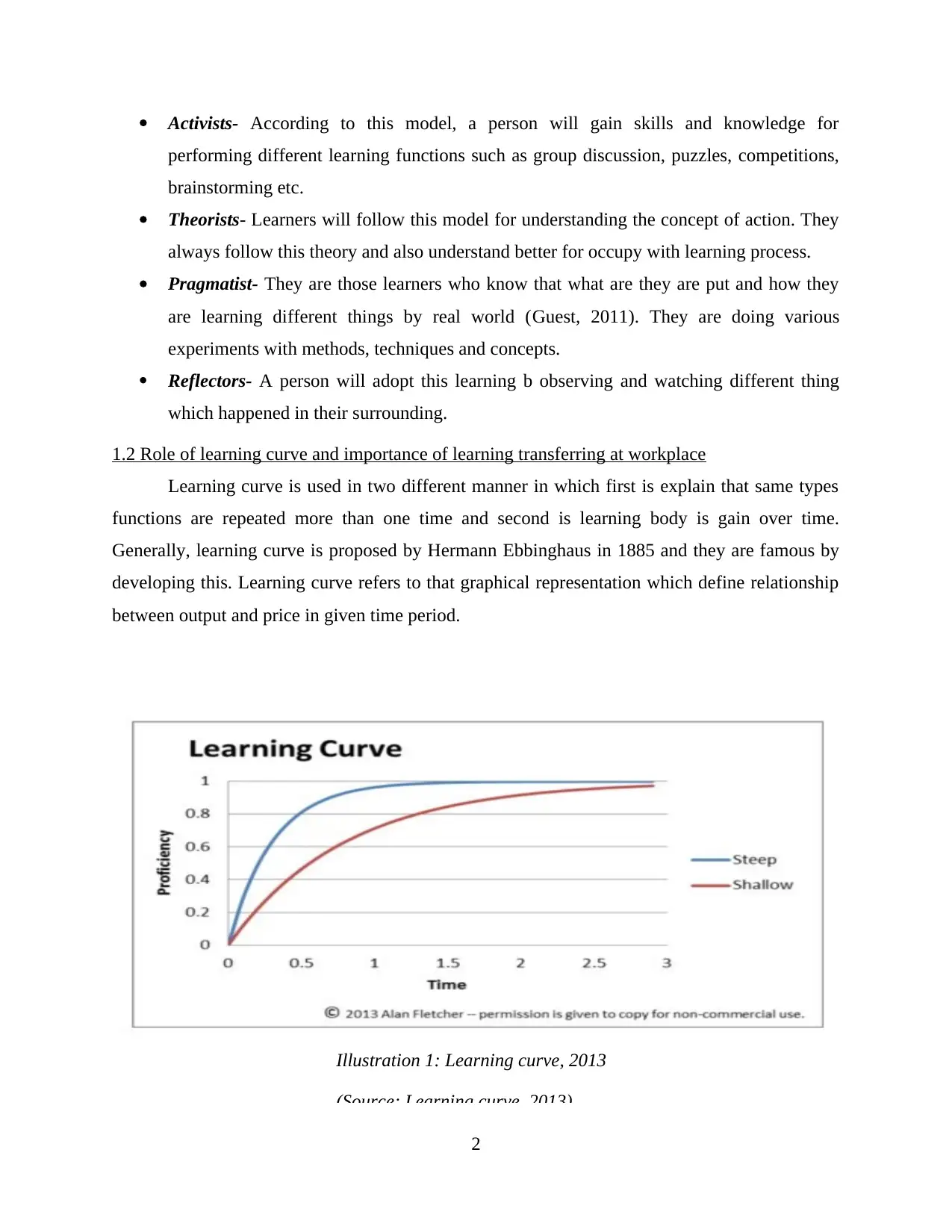
Activists- According to this model, a person will gain skills and knowledge for
performing different learning functions such as group discussion, puzzles, competitions,
brainstorming etc.
Theorists- Learners will follow this model for understanding the concept of action. They
always follow this theory and also understand better for occupy with learning process.
Pragmatist- They are those learners who know that what are they are put and how they
are learning different things by real world (Guest, 2011). They are doing various
experiments with methods, techniques and concepts.
Reflectors- A person will adopt this learning b observing and watching different thing
which happened in their surrounding.
1.2 Role of learning curve and importance of learning transferring at workplace
Learning curve is used in two different manner in which first is explain that same types
functions are repeated more than one time and second is learning body is gain over time.
Generally, learning curve is proposed by Hermann Ebbinghaus in 1885 and they are famous by
developing this. Learning curve refers to that graphical representation which define relationship
between output and price in given time period.
Illustration 1: Learning curve, 2013
(Source: Learning curve, 2013)
2
performing different learning functions such as group discussion, puzzles, competitions,
brainstorming etc.
Theorists- Learners will follow this model for understanding the concept of action. They
always follow this theory and also understand better for occupy with learning process.
Pragmatist- They are those learners who know that what are they are put and how they
are learning different things by real world (Guest, 2011). They are doing various
experiments with methods, techniques and concepts.
Reflectors- A person will adopt this learning b observing and watching different thing
which happened in their surrounding.
1.2 Role of learning curve and importance of learning transferring at workplace
Learning curve is used in two different manner in which first is explain that same types
functions are repeated more than one time and second is learning body is gain over time.
Generally, learning curve is proposed by Hermann Ebbinghaus in 1885 and they are famous by
developing this. Learning curve refers to that graphical representation which define relationship
between output and price in given time period.
Illustration 1: Learning curve, 2013
(Source: Learning curve, 2013)
2
Paraphrase This Document
Need a fresh take? Get an instant paraphrase of this document with our AI Paraphraser
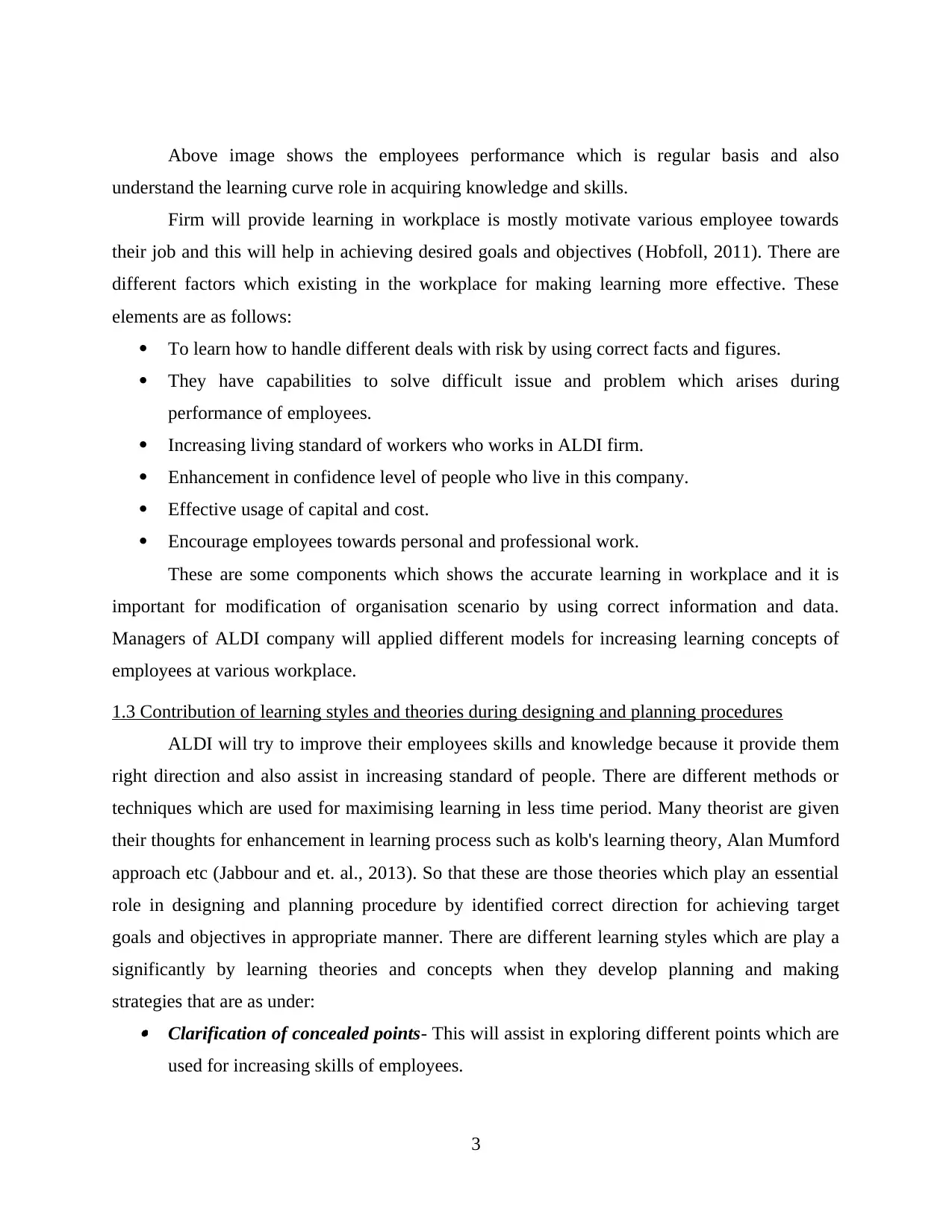
Above image shows the employees performance which is regular basis and also
understand the learning curve role in acquiring knowledge and skills.
Firm will provide learning in workplace is mostly motivate various employee towards
their job and this will help in achieving desired goals and objectives (Hobfoll, 2011). There are
different factors which existing in the workplace for making learning more effective. These
elements are as follows:
To learn how to handle different deals with risk by using correct facts and figures.
They have capabilities to solve difficult issue and problem which arises during
performance of employees.
Increasing living standard of workers who works in ALDI firm.
Enhancement in confidence level of people who live in this company.
Effective usage of capital and cost.
Encourage employees towards personal and professional work.
These are some components which shows the accurate learning in workplace and it is
important for modification of organisation scenario by using correct information and data.
Managers of ALDI company will applied different models for increasing learning concepts of
employees at various workplace.
1.3 Contribution of learning styles and theories during designing and planning procedures
ALDI will try to improve their employees skills and knowledge because it provide them
right direction and also assist in increasing standard of people. There are different methods or
techniques which are used for maximising learning in less time period. Many theorist are given
their thoughts for enhancement in learning process such as kolb's learning theory, Alan Mumford
approach etc (Jabbour and et. al., 2013). So that these are those theories which play an essential
role in designing and planning procedure by identified correct direction for achieving target
goals and objectives in appropriate manner. There are different learning styles which are play a
significantly by learning theories and concepts when they develop planning and making
strategies that are as under: Clarification of concealed points- This will assist in exploring different points which are
used for increasing skills of employees.
3
understand the learning curve role in acquiring knowledge and skills.
Firm will provide learning in workplace is mostly motivate various employee towards
their job and this will help in achieving desired goals and objectives (Hobfoll, 2011). There are
different factors which existing in the workplace for making learning more effective. These
elements are as follows:
To learn how to handle different deals with risk by using correct facts and figures.
They have capabilities to solve difficult issue and problem which arises during
performance of employees.
Increasing living standard of workers who works in ALDI firm.
Enhancement in confidence level of people who live in this company.
Effective usage of capital and cost.
Encourage employees towards personal and professional work.
These are some components which shows the accurate learning in workplace and it is
important for modification of organisation scenario by using correct information and data.
Managers of ALDI company will applied different models for increasing learning concepts of
employees at various workplace.
1.3 Contribution of learning styles and theories during designing and planning procedures
ALDI will try to improve their employees skills and knowledge because it provide them
right direction and also assist in increasing standard of people. There are different methods or
techniques which are used for maximising learning in less time period. Many theorist are given
their thoughts for enhancement in learning process such as kolb's learning theory, Alan Mumford
approach etc (Jabbour and et. al., 2013). So that these are those theories which play an essential
role in designing and planning procedure by identified correct direction for achieving target
goals and objectives in appropriate manner. There are different learning styles which are play a
significantly by learning theories and concepts when they develop planning and making
strategies that are as under: Clarification of concealed points- This will assist in exploring different points which are
used for increasing skills of employees.
3
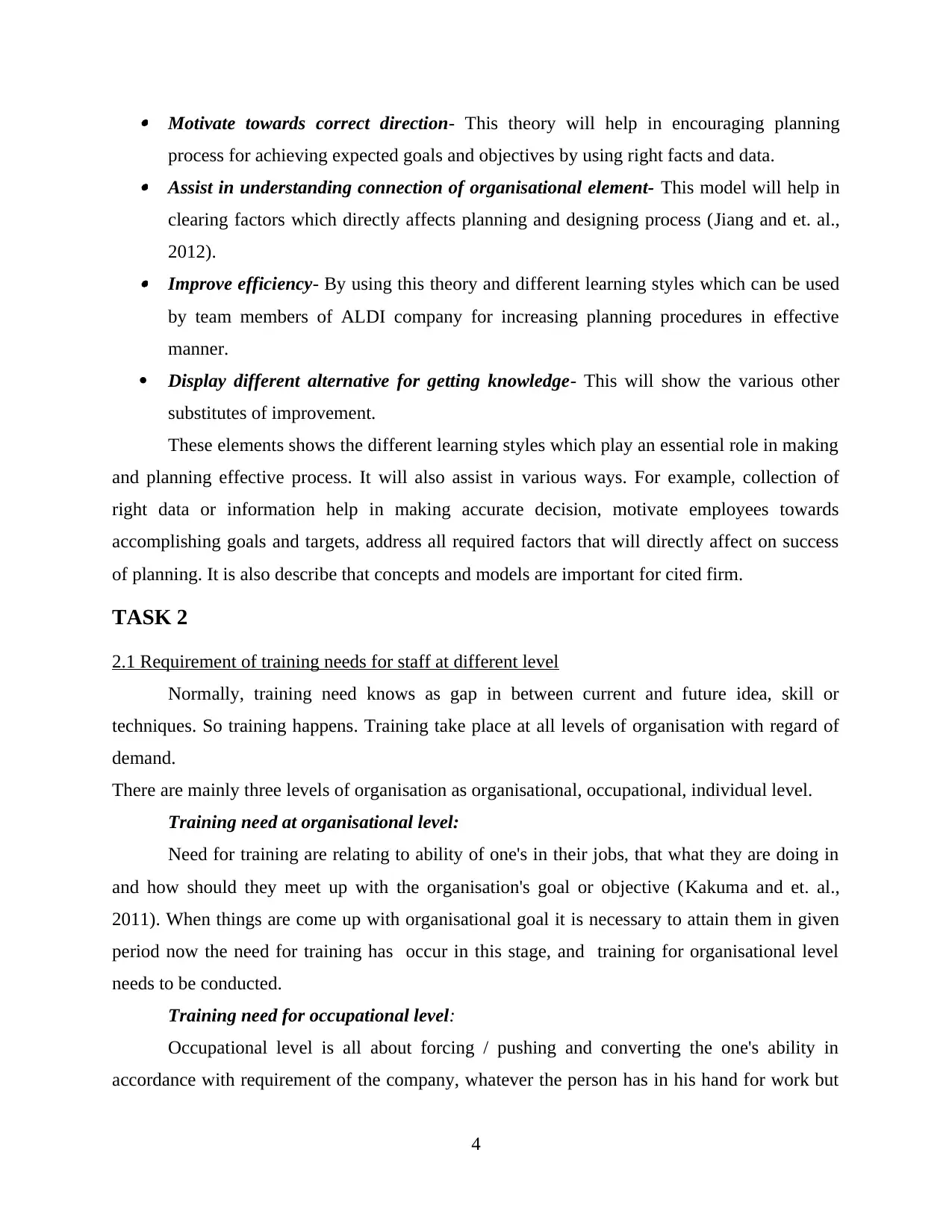
Motivate towards correct direction- This theory will help in encouraging planning
process for achieving expected goals and objectives by using right facts and data. Assist in understanding connection of organisational element- This model will help in
clearing factors which directly affects planning and designing process (Jiang and et. al.,
2012). Improve efficiency- By using this theory and different learning styles which can be used
by team members of ALDI company for increasing planning procedures in effective
manner.
Display different alternative for getting knowledge- This will show the various other
substitutes of improvement.
These elements shows the different learning styles which play an essential role in making
and planning effective process. It will also assist in various ways. For example, collection of
right data or information help in making accurate decision, motivate employees towards
accomplishing goals and targets, address all required factors that will directly affect on success
of planning. It is also describe that concepts and models are important for cited firm.
TASK 2
2.1 Requirement of training needs for staff at different level
Normally, training need knows as gap in between current and future idea, skill or
techniques. So training happens. Training take place at all levels of organisation with regard of
demand.
There are mainly three levels of organisation as organisational, occupational, individual level.
Training need at organisational level:
Need for training are relating to ability of one's in their jobs, that what they are doing in
and how should they meet up with the organisation's goal or objective (Kakuma and et. al.,
2011). When things are come up with organisational goal it is necessary to attain them in given
period now the need for training has occur in this stage, and training for organisational level
needs to be conducted.
Training need for occupational level:
Occupational level is all about forcing / pushing and converting the one's ability in
accordance with requirement of the company, whatever the person has in his hand for work but
4
process for achieving expected goals and objectives by using right facts and data. Assist in understanding connection of organisational element- This model will help in
clearing factors which directly affects planning and designing process (Jiang and et. al.,
2012). Improve efficiency- By using this theory and different learning styles which can be used
by team members of ALDI company for increasing planning procedures in effective
manner.
Display different alternative for getting knowledge- This will show the various other
substitutes of improvement.
These elements shows the different learning styles which play an essential role in making
and planning effective process. It will also assist in various ways. For example, collection of
right data or information help in making accurate decision, motivate employees towards
accomplishing goals and targets, address all required factors that will directly affect on success
of planning. It is also describe that concepts and models are important for cited firm.
TASK 2
2.1 Requirement of training needs for staff at different level
Normally, training need knows as gap in between current and future idea, skill or
techniques. So training happens. Training take place at all levels of organisation with regard of
demand.
There are mainly three levels of organisation as organisational, occupational, individual level.
Training need at organisational level:
Need for training are relating to ability of one's in their jobs, that what they are doing in
and how should they meet up with the organisation's goal or objective (Kakuma and et. al.,
2011). When things are come up with organisational goal it is necessary to attain them in given
period now the need for training has occur in this stage, and training for organisational level
needs to be conducted.
Training need for occupational level:
Occupational level is all about forcing / pushing and converting the one's ability in
accordance with requirement of the company, whatever the person has in his hand for work but
4
⊘ This is a preview!⊘
Do you want full access?
Subscribe today to unlock all pages.

Trusted by 1+ million students worldwide
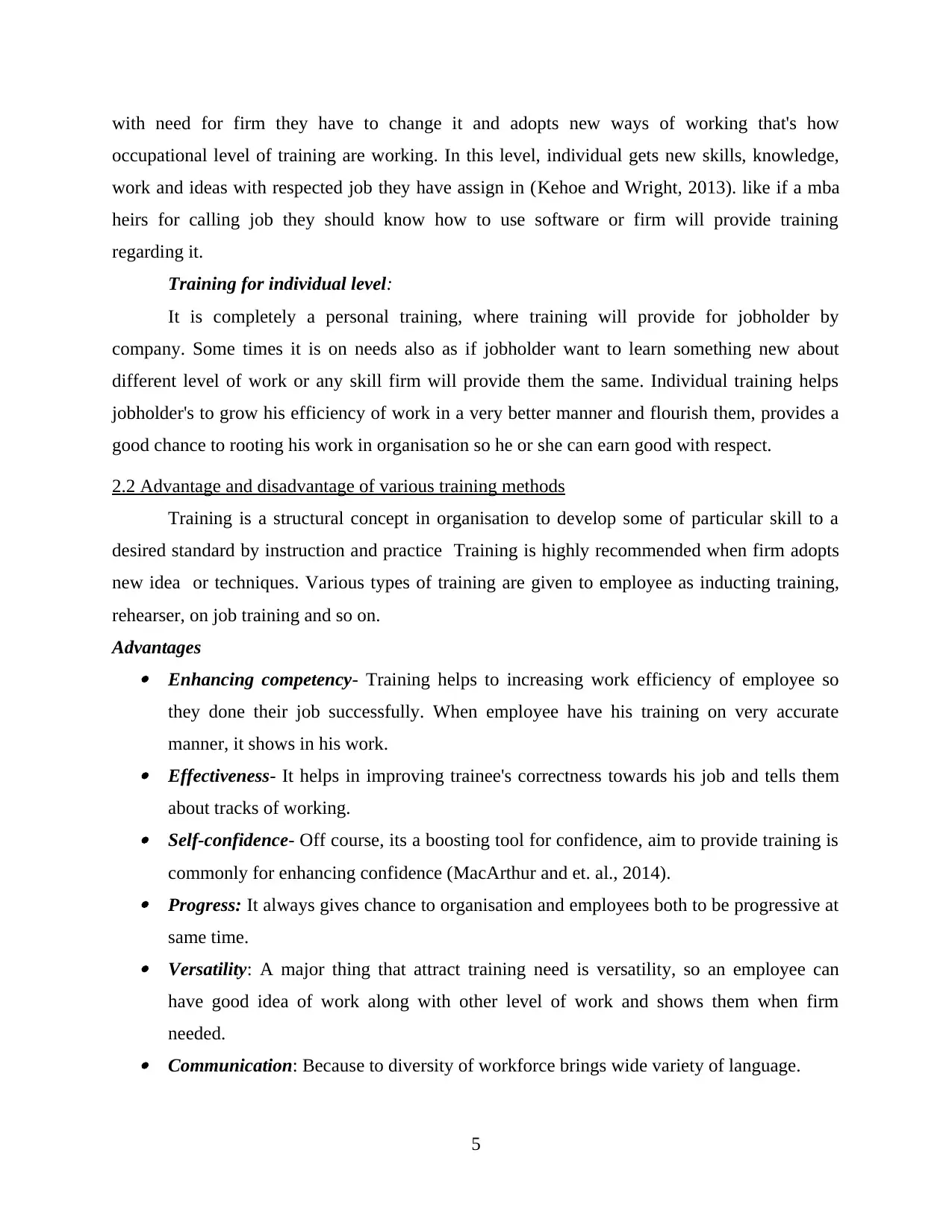
with need for firm they have to change it and adopts new ways of working that's how
occupational level of training are working. In this level, individual gets new skills, knowledge,
work and ideas with respected job they have assign in (Kehoe and Wright, 2013). like if a mba
heirs for calling job they should know how to use software or firm will provide training
regarding it.
Training for individual level:
It is completely a personal training, where training will provide for jobholder by
company. Some times it is on needs also as if jobholder want to learn something new about
different level of work or any skill firm will provide them the same. Individual training helps
jobholder's to grow his efficiency of work in a very better manner and flourish them, provides a
good chance to rooting his work in organisation so he or she can earn good with respect.
2.2 Advantage and disadvantage of various training methods
Training is a structural concept in organisation to develop some of particular skill to a
desired standard by instruction and practice Training is highly recommended when firm adopts
new idea or techniques. Various types of training are given to employee as inducting training,
rehearser, on job training and so on.
Advantages Enhancing competency- Training helps to increasing work efficiency of employee so
they done their job successfully. When employee have his training on very accurate
manner, it shows in his work. Effectiveness- It helps in improving trainee's correctness towards his job and tells them
about tracks of working. Self-confidence- Off course, its a boosting tool for confidence, aim to provide training is
commonly for enhancing confidence (MacArthur and et. al., 2014). Progress: It always gives chance to organisation and employees both to be progressive at
same time. Versatility: A major thing that attract training need is versatility, so an employee can
have good idea of work along with other level of work and shows them when firm
needed. Communication: Because to diversity of workforce brings wide variety of language.
5
occupational level of training are working. In this level, individual gets new skills, knowledge,
work and ideas with respected job they have assign in (Kehoe and Wright, 2013). like if a mba
heirs for calling job they should know how to use software or firm will provide training
regarding it.
Training for individual level:
It is completely a personal training, where training will provide for jobholder by
company. Some times it is on needs also as if jobholder want to learn something new about
different level of work or any skill firm will provide them the same. Individual training helps
jobholder's to grow his efficiency of work in a very better manner and flourish them, provides a
good chance to rooting his work in organisation so he or she can earn good with respect.
2.2 Advantage and disadvantage of various training methods
Training is a structural concept in organisation to develop some of particular skill to a
desired standard by instruction and practice Training is highly recommended when firm adopts
new idea or techniques. Various types of training are given to employee as inducting training,
rehearser, on job training and so on.
Advantages Enhancing competency- Training helps to increasing work efficiency of employee so
they done their job successfully. When employee have his training on very accurate
manner, it shows in his work. Effectiveness- It helps in improving trainee's correctness towards his job and tells them
about tracks of working. Self-confidence- Off course, its a boosting tool for confidence, aim to provide training is
commonly for enhancing confidence (MacArthur and et. al., 2014). Progress: It always gives chance to organisation and employees both to be progressive at
same time. Versatility: A major thing that attract training need is versatility, so an employee can
have good idea of work along with other level of work and shows them when firm
needed. Communication: Because to diversity of workforce brings wide variety of language.
5
Paraphrase This Document
Need a fresh take? Get an instant paraphrase of this document with our AI Paraphraser
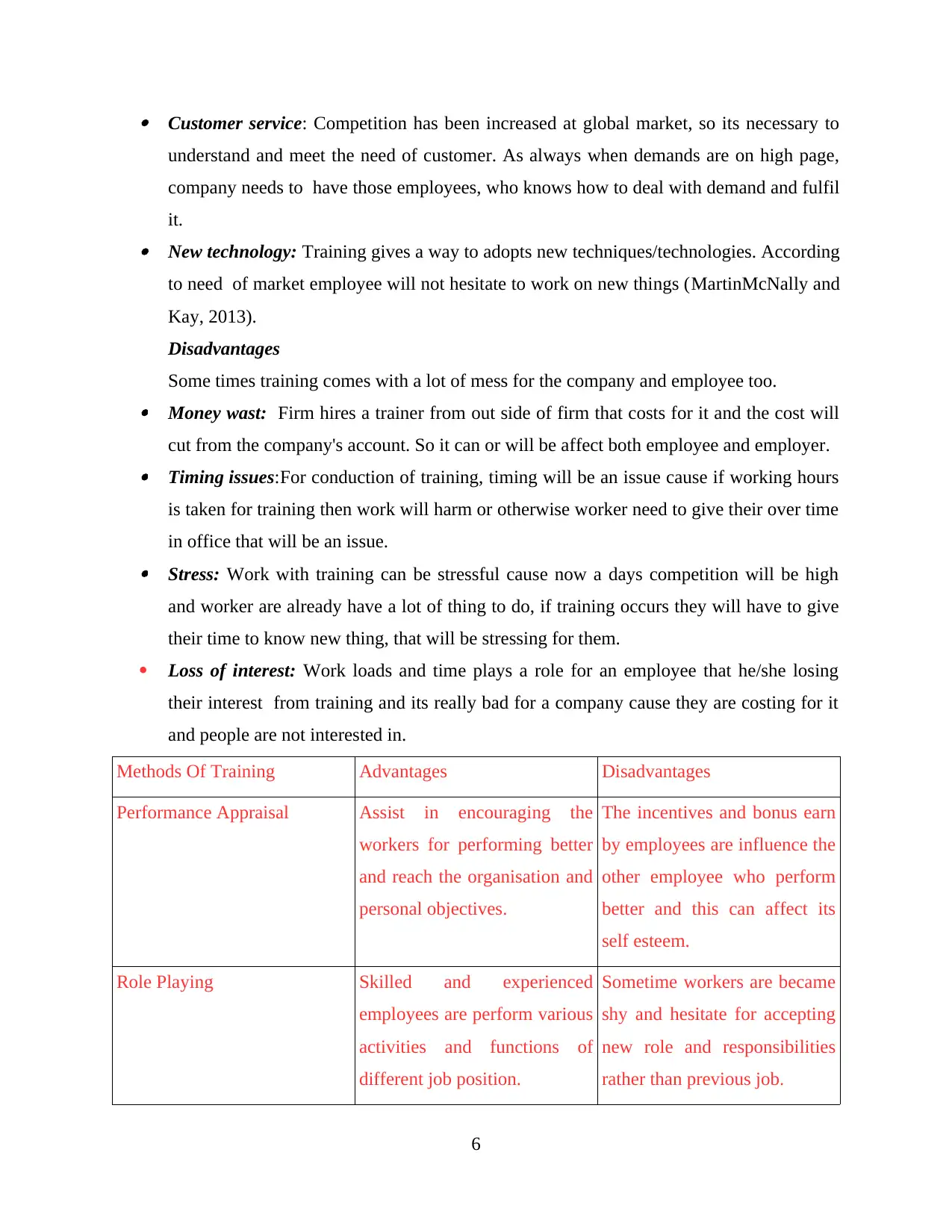
Customer service: Competition has been increased at global market, so its necessary to
understand and meet the need of customer. As always when demands are on high page,
company needs to have those employees, who knows how to deal with demand and fulfil
it. New technology: Training gives a way to adopts new techniques/technologies. According
to need of market employee will not hesitate to work on new things (MartinMcNally and
Kay, 2013).
Disadvantages
Some times training comes with a lot of mess for the company and employee too. Money wast: Firm hires a trainer from out side of firm that costs for it and the cost will
cut from the company's account. So it can or will be affect both employee and employer. Timing issues:For conduction of training, timing will be an issue cause if working hours
is taken for training then work will harm or otherwise worker need to give their over time
in office that will be an issue. Stress: Work with training can be stressful cause now a days competition will be high
and worker are already have a lot of thing to do, if training occurs they will have to give
their time to know new thing, that will be stressing for them.
Loss of interest: Work loads and time plays a role for an employee that he/she losing
their interest from training and its really bad for a company cause they are costing for it
and people are not interested in.
Methods Of Training Advantages Disadvantages
Performance Appraisal Assist in encouraging the
workers for performing better
and reach the organisation and
personal objectives.
The incentives and bonus earn
by employees are influence the
other employee who perform
better and this can affect its
self esteem.
Role Playing Skilled and experienced
employees are perform various
activities and functions of
different job position.
Sometime workers are became
shy and hesitate for accepting
new role and responsibilities
rather than previous job.
6
understand and meet the need of customer. As always when demands are on high page,
company needs to have those employees, who knows how to deal with demand and fulfil
it. New technology: Training gives a way to adopts new techniques/technologies. According
to need of market employee will not hesitate to work on new things (MartinMcNally and
Kay, 2013).
Disadvantages
Some times training comes with a lot of mess for the company and employee too. Money wast: Firm hires a trainer from out side of firm that costs for it and the cost will
cut from the company's account. So it can or will be affect both employee and employer. Timing issues:For conduction of training, timing will be an issue cause if working hours
is taken for training then work will harm or otherwise worker need to give their over time
in office that will be an issue. Stress: Work with training can be stressful cause now a days competition will be high
and worker are already have a lot of thing to do, if training occurs they will have to give
their time to know new thing, that will be stressing for them.
Loss of interest: Work loads and time plays a role for an employee that he/she losing
their interest from training and its really bad for a company cause they are costing for it
and people are not interested in.
Methods Of Training Advantages Disadvantages
Performance Appraisal Assist in encouraging the
workers for performing better
and reach the organisation and
personal objectives.
The incentives and bonus earn
by employees are influence the
other employee who perform
better and this can affect its
self esteem.
Role Playing Skilled and experienced
employees are perform various
activities and functions of
different job position.
Sometime workers are became
shy and hesitate for accepting
new role and responsibilities
rather than previous job.
6
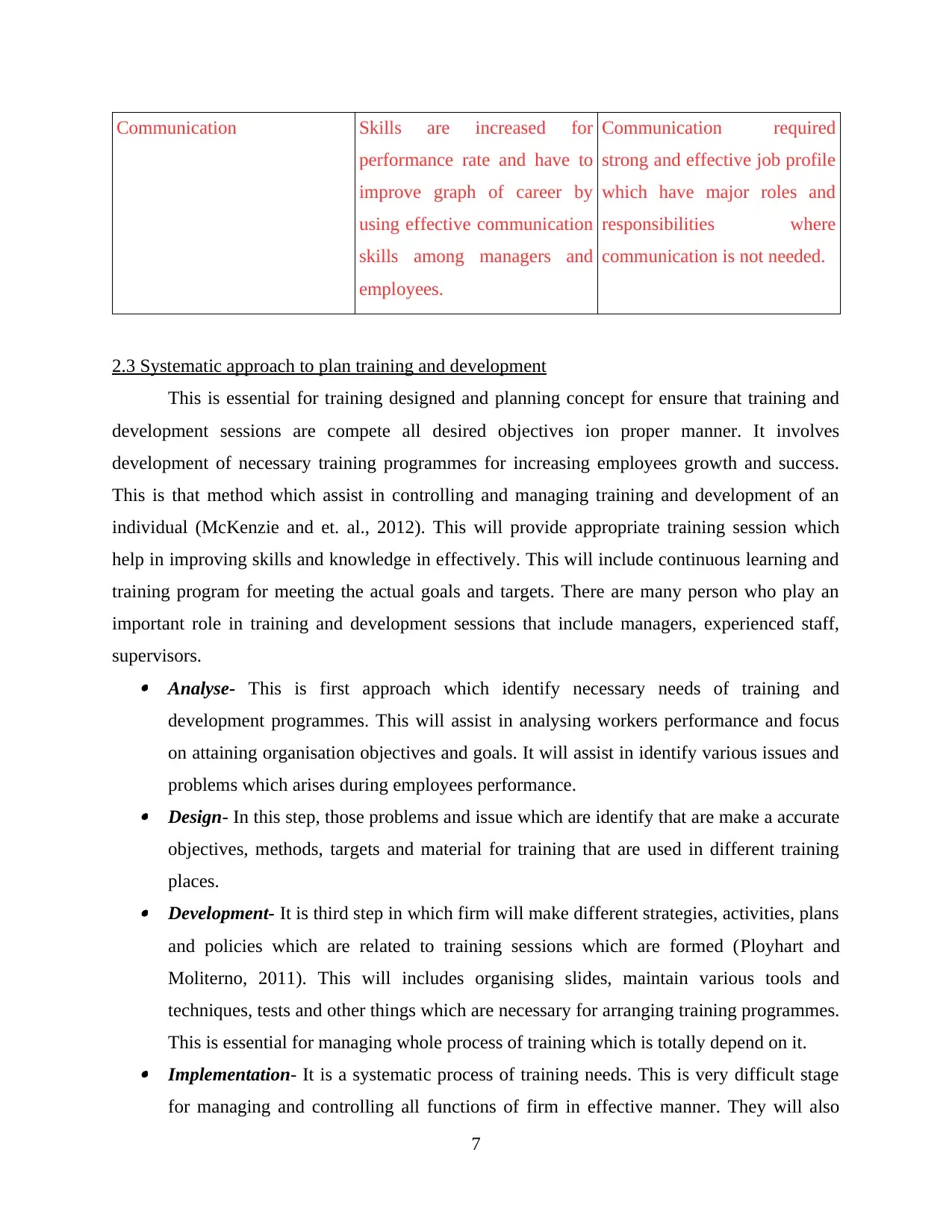
Communication Skills are increased for
performance rate and have to
improve graph of career by
using effective communication
skills among managers and
employees.
Communication required
strong and effective job profile
which have major roles and
responsibilities where
communication is not needed.
2.3 Systematic approach to plan training and development
This is essential for training designed and planning concept for ensure that training and
development sessions are compete all desired objectives ion proper manner. It involves
development of necessary training programmes for increasing employees growth and success.
This is that method which assist in controlling and managing training and development of an
individual (McKenzie and et. al., 2012). This will provide appropriate training session which
help in improving skills and knowledge in effectively. This will include continuous learning and
training program for meeting the actual goals and targets. There are many person who play an
important role in training and development sessions that include managers, experienced staff,
supervisors. Analyse- This is first approach which identify necessary needs of training and
development programmes. This will assist in analysing workers performance and focus
on attaining organisation objectives and goals. It will assist in identify various issues and
problems which arises during employees performance. Design- In this step, those problems and issue which are identify that are make a accurate
objectives, methods, targets and material for training that are used in different training
places. Development- It is third step in which firm will make different strategies, activities, plans
and policies which are related to training sessions which are formed (Ployhart and
Moliterno, 2011). This will includes organising slides, maintain various tools and
techniques, tests and other things which are necessary for arranging training programmes.
This is essential for managing whole process of training which is totally depend on it. Implementation- It is a systematic process of training needs. This is very difficult stage
for managing and controlling all functions of firm in effective manner. They will also
7
performance rate and have to
improve graph of career by
using effective communication
skills among managers and
employees.
Communication required
strong and effective job profile
which have major roles and
responsibilities where
communication is not needed.
2.3 Systematic approach to plan training and development
This is essential for training designed and planning concept for ensure that training and
development sessions are compete all desired objectives ion proper manner. It involves
development of necessary training programmes for increasing employees growth and success.
This is that method which assist in controlling and managing training and development of an
individual (McKenzie and et. al., 2012). This will provide appropriate training session which
help in improving skills and knowledge in effectively. This will include continuous learning and
training program for meeting the actual goals and targets. There are many person who play an
important role in training and development sessions that include managers, experienced staff,
supervisors. Analyse- This is first approach which identify necessary needs of training and
development programmes. This will assist in analysing workers performance and focus
on attaining organisation objectives and goals. It will assist in identify various issues and
problems which arises during employees performance. Design- In this step, those problems and issue which are identify that are make a accurate
objectives, methods, targets and material for training that are used in different training
places. Development- It is third step in which firm will make different strategies, activities, plans
and policies which are related to training sessions which are formed (Ployhart and
Moliterno, 2011). This will includes organising slides, maintain various tools and
techniques, tests and other things which are necessary for arranging training programmes.
This is essential for managing whole process of training which is totally depend on it. Implementation- It is a systematic process of training needs. This is very difficult stage
for managing and controlling all functions of firm in effective manner. They will also
7
⊘ This is a preview!⊘
Do you want full access?
Subscribe today to unlock all pages.

Trusted by 1+ million students worldwide
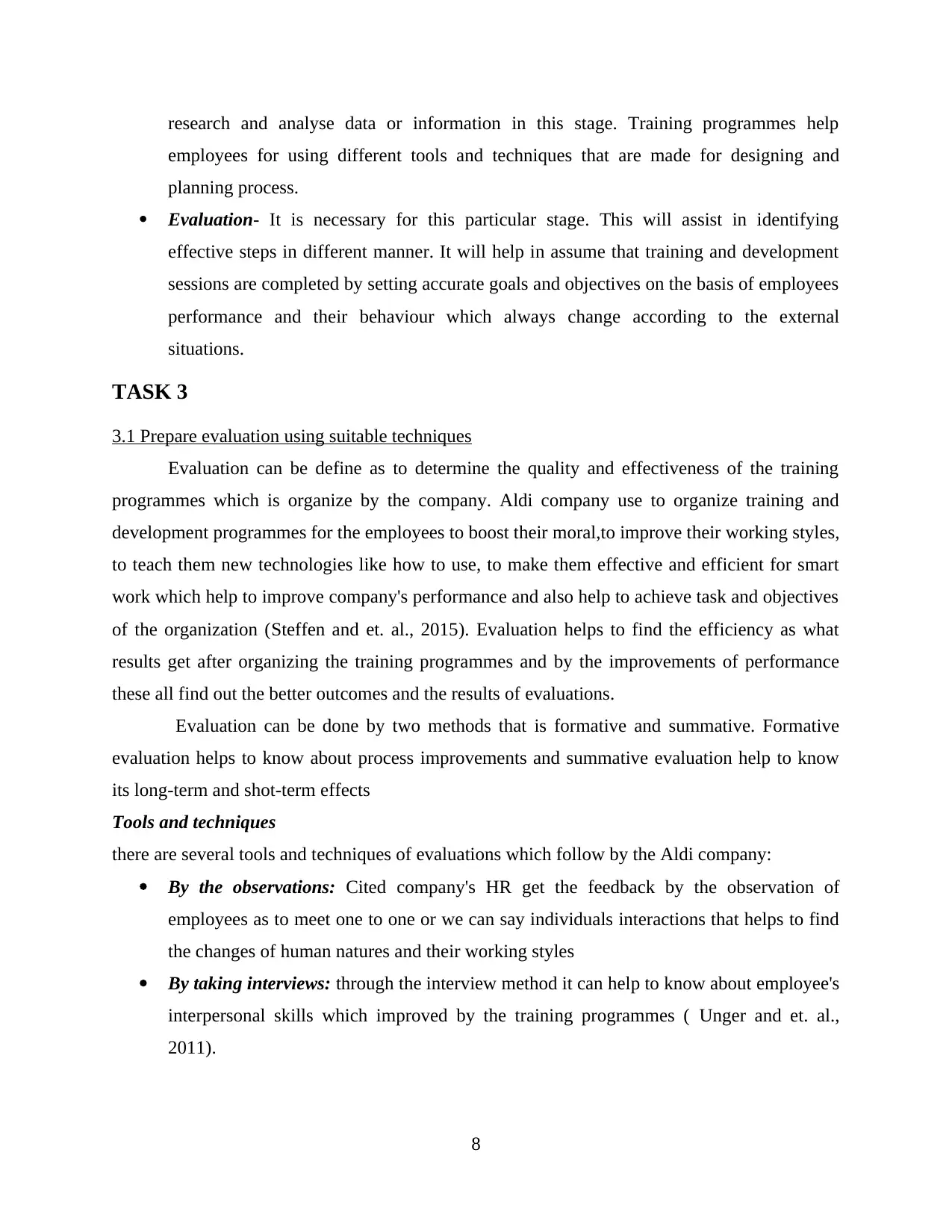
research and analyse data or information in this stage. Training programmes help
employees for using different tools and techniques that are made for designing and
planning process.
Evaluation- It is necessary for this particular stage. This will assist in identifying
effective steps in different manner. It will help in assume that training and development
sessions are completed by setting accurate goals and objectives on the basis of employees
performance and their behaviour which always change according to the external
situations.
TASK 3
3.1 Prepare evaluation using suitable techniques
Evaluation can be define as to determine the quality and effectiveness of the training
programmes which is organize by the company. Aldi company use to organize training and
development programmes for the employees to boost their moral,to improve their working styles,
to teach them new technologies like how to use, to make them effective and efficient for smart
work which help to improve company's performance and also help to achieve task and objectives
of the organization (Steffen and et. al., 2015). Evaluation helps to find the efficiency as what
results get after organizing the training programmes and by the improvements of performance
these all find out the better outcomes and the results of evaluations.
Evaluation can be done by two methods that is formative and summative. Formative
evaluation helps to know about process improvements and summative evaluation help to know
its long-term and shot-term effects
Tools and techniques
there are several tools and techniques of evaluations which follow by the Aldi company:
By the observations: Cited company's HR get the feedback by the observation of
employees as to meet one to one or we can say individuals interactions that helps to find
the changes of human natures and their working styles
By taking interviews: through the interview method it can help to know about employee's
interpersonal skills which improved by the training programmes ( Unger and et. al.,
2011).
8
employees for using different tools and techniques that are made for designing and
planning process.
Evaluation- It is necessary for this particular stage. This will assist in identifying
effective steps in different manner. It will help in assume that training and development
sessions are completed by setting accurate goals and objectives on the basis of employees
performance and their behaviour which always change according to the external
situations.
TASK 3
3.1 Prepare evaluation using suitable techniques
Evaluation can be define as to determine the quality and effectiveness of the training
programmes which is organize by the company. Aldi company use to organize training and
development programmes for the employees to boost their moral,to improve their working styles,
to teach them new technologies like how to use, to make them effective and efficient for smart
work which help to improve company's performance and also help to achieve task and objectives
of the organization (Steffen and et. al., 2015). Evaluation helps to find the efficiency as what
results get after organizing the training programmes and by the improvements of performance
these all find out the better outcomes and the results of evaluations.
Evaluation can be done by two methods that is formative and summative. Formative
evaluation helps to know about process improvements and summative evaluation help to know
its long-term and shot-term effects
Tools and techniques
there are several tools and techniques of evaluations which follow by the Aldi company:
By the observations: Cited company's HR get the feedback by the observation of
employees as to meet one to one or we can say individuals interactions that helps to find
the changes of human natures and their working styles
By taking interviews: through the interview method it can help to know about employee's
interpersonal skills which improved by the training programmes ( Unger and et. al.,
2011).
8
Paraphrase This Document
Need a fresh take? Get an instant paraphrase of this document with our AI Paraphraser
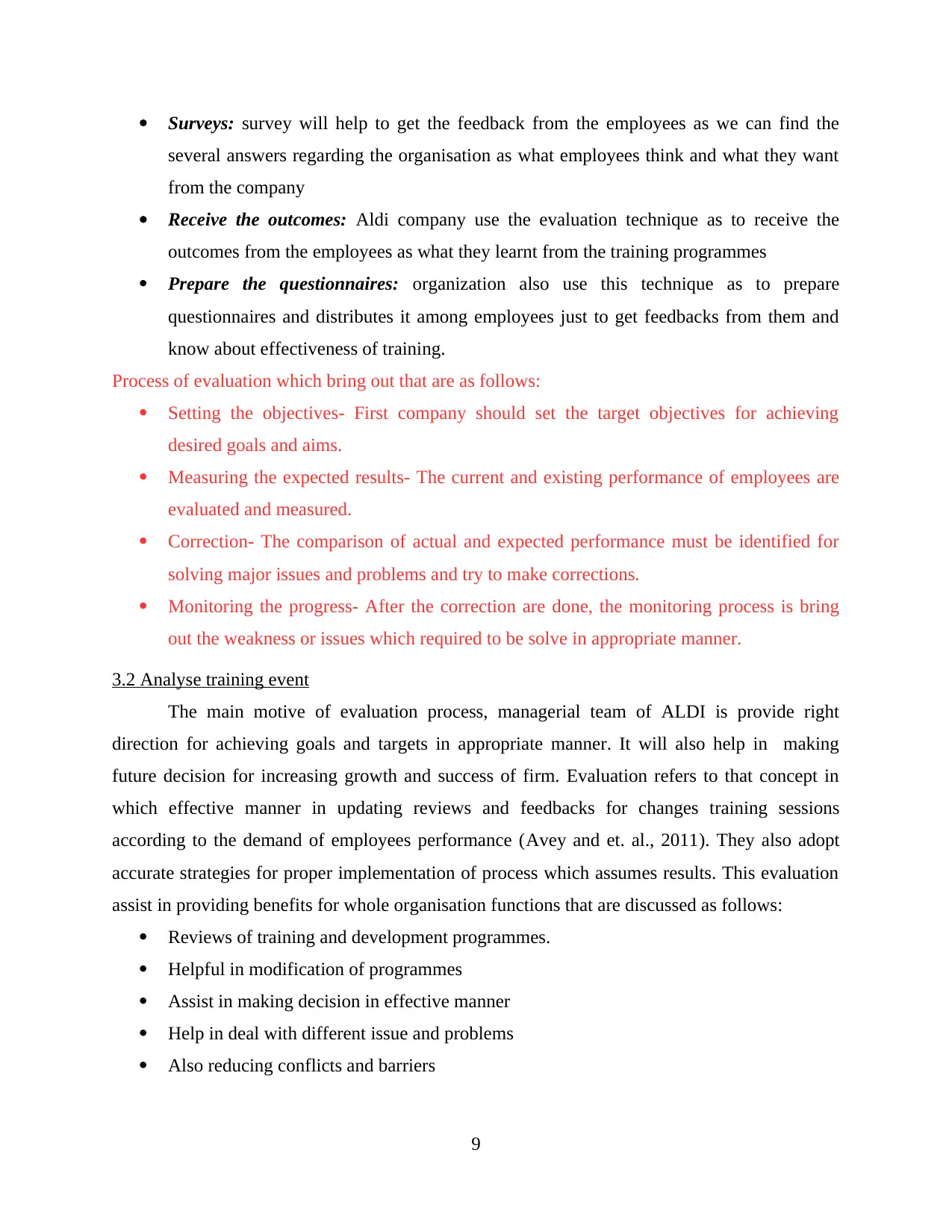
Surveys: survey will help to get the feedback from the employees as we can find the
several answers regarding the organisation as what employees think and what they want
from the company
Receive the outcomes: Aldi company use the evaluation technique as to receive the
outcomes from the employees as what they learnt from the training programmes
Prepare the questionnaires: organization also use this technique as to prepare
questionnaires and distributes it among employees just to get feedbacks from them and
know about effectiveness of training.
Process of evaluation which bring out that are as follows:
Setting the objectives- First company should set the target objectives for achieving
desired goals and aims.
Measuring the expected results- The current and existing performance of employees are
evaluated and measured.
Correction- The comparison of actual and expected performance must be identified for
solving major issues and problems and try to make corrections.
Monitoring the progress- After the correction are done, the monitoring process is bring
out the weakness or issues which required to be solve in appropriate manner.
3.2 Analyse training event
The main motive of evaluation process, managerial team of ALDI is provide right
direction for achieving goals and targets in appropriate manner. It will also help in making
future decision for increasing growth and success of firm. Evaluation refers to that concept in
which effective manner in updating reviews and feedbacks for changes training sessions
according to the demand of employees performance (Avey and et. al., 2011). They also adopt
accurate strategies for proper implementation of process which assumes results. This evaluation
assist in providing benefits for whole organisation functions that are discussed as follows:
Reviews of training and development programmes.
Helpful in modification of programmes
Assist in making decision in effective manner
Help in deal with different issue and problems
Also reducing conflicts and barriers
9
several answers regarding the organisation as what employees think and what they want
from the company
Receive the outcomes: Aldi company use the evaluation technique as to receive the
outcomes from the employees as what they learnt from the training programmes
Prepare the questionnaires: organization also use this technique as to prepare
questionnaires and distributes it among employees just to get feedbacks from them and
know about effectiveness of training.
Process of evaluation which bring out that are as follows:
Setting the objectives- First company should set the target objectives for achieving
desired goals and aims.
Measuring the expected results- The current and existing performance of employees are
evaluated and measured.
Correction- The comparison of actual and expected performance must be identified for
solving major issues and problems and try to make corrections.
Monitoring the progress- After the correction are done, the monitoring process is bring
out the weakness or issues which required to be solve in appropriate manner.
3.2 Analyse training event
The main motive of evaluation process, managerial team of ALDI is provide right
direction for achieving goals and targets in appropriate manner. It will also help in making
future decision for increasing growth and success of firm. Evaluation refers to that concept in
which effective manner in updating reviews and feedbacks for changes training sessions
according to the demand of employees performance (Avey and et. al., 2011). They also adopt
accurate strategies for proper implementation of process which assumes results. This evaluation
assist in providing benefits for whole organisation functions that are discussed as follows:
Reviews of training and development programmes.
Helpful in modification of programmes
Assist in making decision in effective manner
Help in deal with different issue and problems
Also reducing conflicts and barriers
9
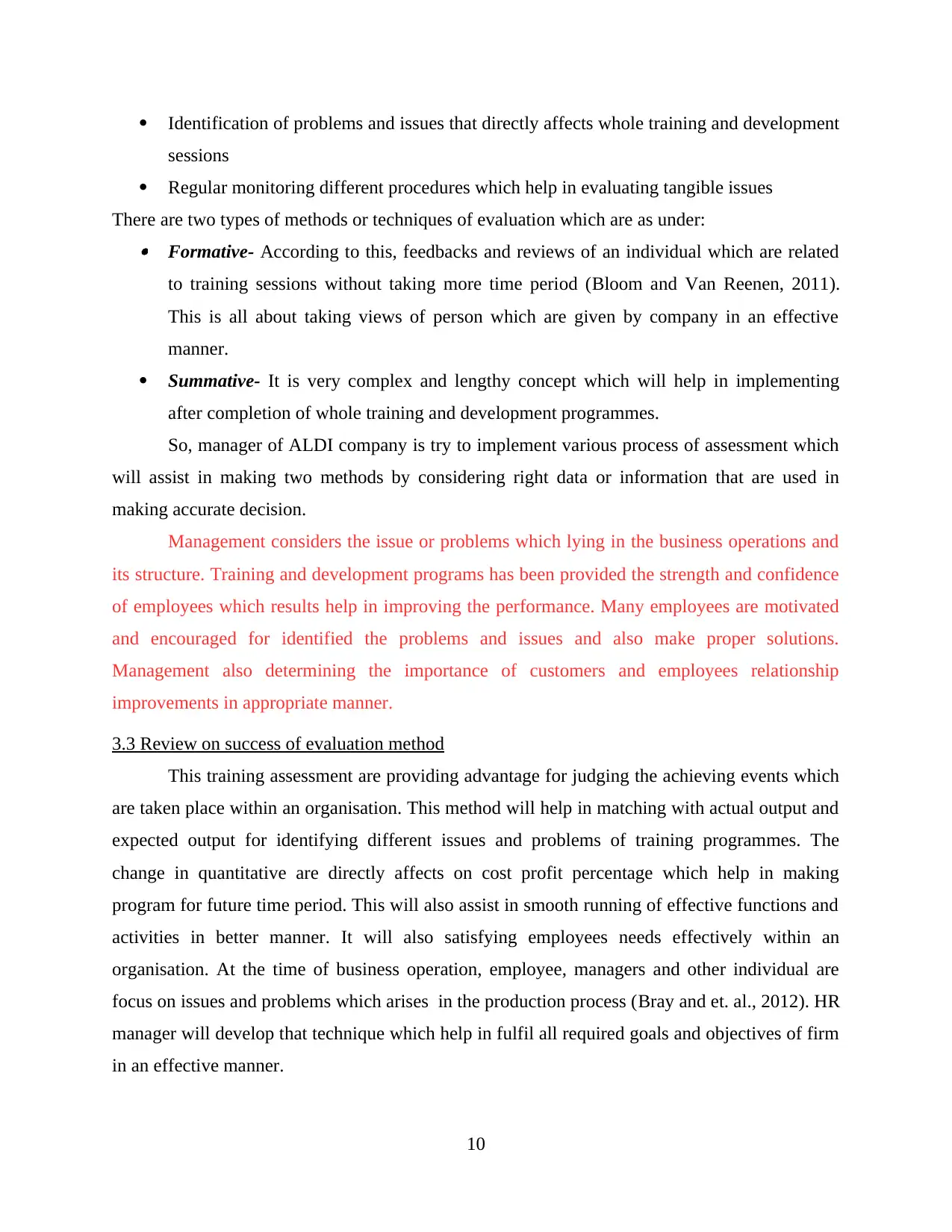
Identification of problems and issues that directly affects whole training and development
sessions
Regular monitoring different procedures which help in evaluating tangible issues
There are two types of methods or techniques of evaluation which are as under: Formative- According to this, feedbacks and reviews of an individual which are related
to training sessions without taking more time period (Bloom and Van Reenen, 2011).
This is all about taking views of person which are given by company in an effective
manner.
Summative- It is very complex and lengthy concept which will help in implementing
after completion of whole training and development programmes.
So, manager of ALDI company is try to implement various process of assessment which
will assist in making two methods by considering right data or information that are used in
making accurate decision.
Management considers the issue or problems which lying in the business operations and
its structure. Training and development programs has been provided the strength and confidence
of employees which results help in improving the performance. Many employees are motivated
and encouraged for identified the problems and issues and also make proper solutions.
Management also determining the importance of customers and employees relationship
improvements in appropriate manner.
3.3 Review on success of evaluation method
This training assessment are providing advantage for judging the achieving events which
are taken place within an organisation. This method will help in matching with actual output and
expected output for identifying different issues and problems of training programmes. The
change in quantitative are directly affects on cost profit percentage which help in making
program for future time period. This will also assist in smooth running of effective functions and
activities in better manner. It will also satisfying employees needs effectively within an
organisation. At the time of business operation, employee, managers and other individual are
focus on issues and problems which arises in the production process (Bray and et. al., 2012). HR
manager will develop that technique which help in fulfil all required goals and objectives of firm
in an effective manner.
10
sessions
Regular monitoring different procedures which help in evaluating tangible issues
There are two types of methods or techniques of evaluation which are as under: Formative- According to this, feedbacks and reviews of an individual which are related
to training sessions without taking more time period (Bloom and Van Reenen, 2011).
This is all about taking views of person which are given by company in an effective
manner.
Summative- It is very complex and lengthy concept which will help in implementing
after completion of whole training and development programmes.
So, manager of ALDI company is try to implement various process of assessment which
will assist in making two methods by considering right data or information that are used in
making accurate decision.
Management considers the issue or problems which lying in the business operations and
its structure. Training and development programs has been provided the strength and confidence
of employees which results help in improving the performance. Many employees are motivated
and encouraged for identified the problems and issues and also make proper solutions.
Management also determining the importance of customers and employees relationship
improvements in appropriate manner.
3.3 Review on success of evaluation method
This training assessment are providing advantage for judging the achieving events which
are taken place within an organisation. This method will help in matching with actual output and
expected output for identifying different issues and problems of training programmes. The
change in quantitative are directly affects on cost profit percentage which help in making
program for future time period. This will also assist in smooth running of effective functions and
activities in better manner. It will also satisfying employees needs effectively within an
organisation. At the time of business operation, employee, managers and other individual are
focus on issues and problems which arises in the production process (Bray and et. al., 2012). HR
manager will develop that technique which help in fulfil all required goals and objectives of firm
in an effective manner.
10
⊘ This is a preview!⊘
Do you want full access?
Subscribe today to unlock all pages.

Trusted by 1+ million students worldwide
1 out of 18
Related Documents
Your All-in-One AI-Powered Toolkit for Academic Success.
+13062052269
info@desklib.com
Available 24*7 on WhatsApp / Email
![[object Object]](/_next/static/media/star-bottom.7253800d.svg)
Unlock your academic potential
Copyright © 2020–2025 A2Z Services. All Rights Reserved. Developed and managed by ZUCOL.





